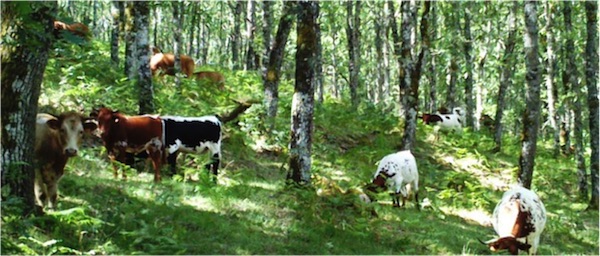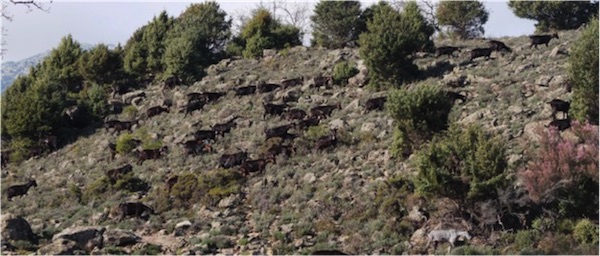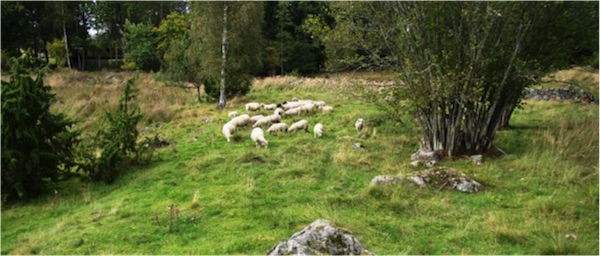Our most environmentally valuable farmland is condemned to a slow death by a combination of EU bureaucracy and national decisions. CAP’s so called ‘greening’ ties up farmers in bureaucracy, uses valuable public money and still fails to protect nature or the incomes of farmers in marginalised areas adequately. There are however solutions.
Goats grazing in a Natura 2000 site in central Spain. The pasture is not herbaceous so it is only eligible for CAP payments with special justifications based on established local practices. Author: Guy Beaufoy #greening
By Guy Beaufoy, (Senior Policy Manager, European Forum on Nature Conservation and Pastoralism)
The European Forum on Nature Conservation and Pastoralism (EFNCP ) has recently released a number of country reports.
Greening as it currently operates at EU and Member State level emerges as, for the EFNCP, a “fundamentally flawed EU policy model, especially for semi-natural or High Nature Value pastures.”
NEW! Read Oliver Moore’s article on the EFNCP report on Ireland, with extra info on results-based schemes at www.arc2020.eu/2016/04/ireland-cap-greening-failing-farmers-and-nature/
EFNCP reports examine the application of the new “green” CAP to permanent pastures in 6 Member States: Bulgaria, Estonia, France, Ireland, Spain and UK. Note 1. The overall picture is one of a fundamentally flawed EU policy model, especially for semi-natural pastures. The mainstream CAP instruments in Pillar 1 fail to address the main challenges and even exacerbate the threat of abandonment or damaging actions by farmers in some situations.
Background
A large part of Europe’s permanent pasture is broadly semi-natural, meaning that it has not been recently reseeded or heavily fertilised and is similar to a natural habitat. These semi-natural permanent pastures are of exceptional biodiversity compared with intensively managed permanent pasture, and have been labelled as High Nature Value farmland. They are also an extremely valuable carbon store. Reseeding and fertilisation result in more grass production, but cause biodiversity to be greatly reduced and carbon storage to be reversed.
Some semi-natural pastures are largely herbaceous (i.e. grass), while others are dominated by shrubs (e.g. heather moorland), or trees, or both. In some cases, trees are an integral part of the forage system, the leaves and fruits providing an important seasonal complement to herbaceous and shrub forage (e.g. Iberian dehesas, Nordic wooded meadows).
Under the new CAP Sweden has resolved some eligibility issues for woody pastures. Author: Peter Einarsson. #greening
Semi-natural permanent pastures under active farming use cover many millions of hectares of EU farmland, often in more marginal farming situations, and are responsible for a major part of the environmental public goods produced by European farming. They are declining in some cases as a result of intensification (especially reseeding and heavy fertilisation of meadows) but mainly due to abandonment and afforestation.
CAP
The CAP fails to recognise the threats from abandonment, afforestation or other intensification or to adequately address the challenges. A greener CAP focusing on public goods needs to encourage the continuation of extensive farming on semi-natural pastures, but instead it is imposing ever more bureaucratic restrictions.
A major issue in most countries studied are the rules governing the eligibility of pastures with trees and shrubs for receiving CAP support. In the past, farmers who grazed their animals on this woody pasture were eligible for CAP payments per head of livestock, but since 2005 the support has shifted to payments per hectare, with new and complicated rules that discriminate against pastures with trees and shrubs. Member States must either impose an arbitrary limit of 100 trees per hectare of land (any more trees and the land becomes ineligible, or “dead land” in the words of a Spanish farmers’ organisation), or devise a complex system for reducing each farmer’s eligible area in proportion to the presence of trees and shrubs. The result of this system is that farmers are incentivised to remove these valuable features, to abandon the pastures altogether, or to convert them to forestry use. Such changes lead to a major loss of biodiversity, of valued landscapes and of cultural heritage.
By using special clauses and justifications, Member States can count woody pastures with “established local practices” as eligible, so long as they can demonstrate that each tree and shrub is grazed for its whole area. Implementing these clauses is a considerable administrative burden, and not surprisingly many Member States have not done so, with the result that large areas of semi-natural pastures with trees and/or shrubs have been penalised or excluded from CAP support, including in Ireland.
 It is common for cows in Spain to graze in oak wood pasture for most of the year, but the land is not eligible for CAP payments because there are “too many trees”. Author: Guy Beaufoy #greening
It is common for cows in Spain to graze in oak wood pasture for most of the year, but the land is not eligible for CAP payments because there are “too many trees”. Author: Guy Beaufoy #greening
EFNCP has revealed very large exclusions of actively farmed woody pastures from Pillar 1 support in some countries, such as Bulgaria, and major new exclusions in Spain as DG AGRI has demanded a much more restrictive system than in the past. Even where the system has improved, there are still considerable exclusions as in Estonia and Sweden. Some countries have found ways to avoid exclusions or losses of eligibility for pastures (e.g. England, France), but their approaches are not seen favourably by DG AGRI.
There are very large differences between Member States in levels of financial support allocated to permanent pastures under Pillar 1, due to national implementing decisions. The result is very low payments per hectare in some countries (e.g. Spain), very high payments in some others (e.g. in Northern Ireland) and a range of payment levels in between. If Pillar 2 payments are taken into account, these differences become enormous. For example, an extensive livestock farm in the French Pyrenees can receive hundreds more euros in support for each hectare of pasture than an identical farm claiming all available payments on the Spanish side of the border.
Headage payments for livestock also show a wide range of payment levels between countries. Some countries are not applying coupled payments at all, so there is by no means a level playing-field for livestock farming across the EU.
The weak EU rules governing the minimum activity required on farmland to justify Pillar 1 payments mean that someone who merely cuts a field of grass every one or two years, leaving the cuttings on the ground without really farming, gets the same payment as an active farmer raising livestock and conserving species-rich pastures through appropriate grazing. This encourages “subsidy farmers” to acquire farmland but not to farm it, a situation quite widespread in some countries.
Problems with CAP Pillar 1 and 2
The CAP “greening” mechanism – ostensibly about preventing the decline in permanent pastures – is hopelessly flawed, as it allows ploughing and reseeding to be carried out annually, thus destroying the environmental value and carbon storage of semi-natural pastures. New restrictions on ploughing or converting so-called Environmentally Sensitive Permanent Grasslands (ESPG) merely replicate existing protection for grasslands within Natura 2000, but fail to address the widespread threat of abandonment of these grasslands, whether within those sites or elsewhere.
Some of the key problems in Pillar 1 (direct payments) can be corrected in part by Member States’ implementation decisions, if they have the will and administrative resources to make use of all available exceptions and clauses, and can stand up to “conformist” pressure from European Commission auditors (DG AGRI). But the EFNCP reports reveal a very mixed picture across the 6 Member States, with some positive examples of policy implementation, but too many examples of negative policy drivers overall, and of CAP instruments for pastures that sound useful on paper but are of very limited practical benefit in reality.
Meanwhile Pillar 2 (agri-environment and rural development) offers many opportunities for Member States to take positive action for permanent pastures, by investing their own financial and administrative resources, for example in agri-environment-climate measures, but there is no obligation for them to do so. Some countries are implementing positive Pillar 2 measures for semi-natural pastures, especially within Natura 2000 (e.g. in Bulgaria, Estonia, France and UK). The Natura 2000 network receives far less positive support.
However, Member States seem to be allowed to ignore obvious environmental challenges for pastures with impunity. For example, despite clear data held by EC on the unfavourable condition of the majority of semi-natural grassland in Annex 1 of the Habitats Directive in Spain, this country has been allowed to implement yet another round of Rural Development Plans (RDPs) that completely fail to respond to the EU targets for these habitats, while making very little use of agri-environment-climate or Natura 2000 measures for improving their condition.
Policy Improvements
Based on its research, EFNCP proposes the following policy improvements.
The definition of permanent pastures eligible for CAP support should include all pastures and forage in active farming, without requiring special justifications for pastures that are not predominantly grass, which creates extra administrative burdens and risks of penalties for farmers and national authorities. Simplifying eligibility criteria for these pastures should be a prime target of efforts to reduce unnecessary CAP bureaucracy.
On farmland, trees and shrubs should not be treated a priori as non-productive elements. They should be seen as adding value to farmland, unless they clearly impede farming activity. There should be no arbitrary and unscientific limit for tree numbers on pastures set at EU level and no reductions in eligibility for CAP payments due to the presence of trees and shrubs if there is an acceptable level of farming use. In determining eligibility for CAP payments, the actual use of the land should have priority over the type of vegetation.
Under the current rules, the CAP gives full direct payments on grasslands that are taken out of farming and converted to forestry, but penalises wood pastures, even those in active farming. This is completely incoherent and should be changed.
Member states should make full use of rural development programme (RDP) measures for supporting positive management of semi-natural pastures, including woody pastures. RDP grants for afforestation of pastures and abandonment of farming must not be more attractive (economically or in terms of their administrative simplicity) than the available incentives for the continued farming and conservation of semi-natural pastures.
Note 1. See individual country reports, including Ireland and UK, at www.efncp.org/news/news20160127.php
Guy Beaufoy is Senior Policy Manager European Forum on Nature Conservation and Pastoralism (EFNCP). The European Forum on Nature Conservation and Pastoralism brings together ecologists, nature conservationists, farmers and policy makers. This non-profit network exists to increase understanding of the nature-conservation and cultural value of certain farming systems, and to inform work on their maintenance. For more information, see www.efncp.org
Originally posted on 29 March, 2016 by ARC 2020: Agricultural and Rural Convention at www.arc2020.eu/2016/03/cap-greening-threatens-ecologically-precious-land/ For more information on the work of ARC 2020, see www.arc2020.eu/who-we-are/




No comments yet, add your own below